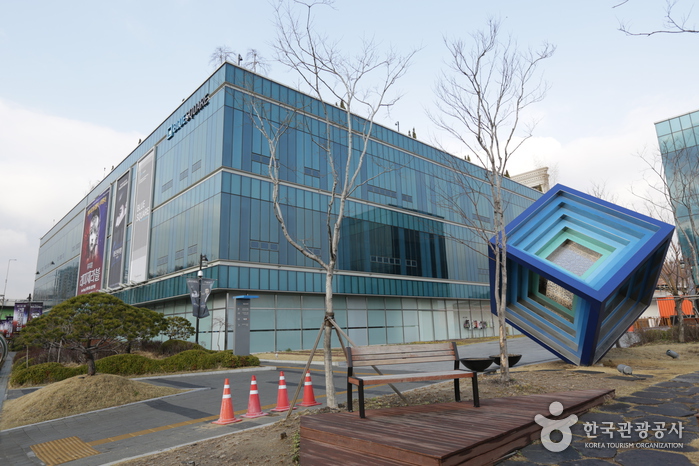Blue Square (블루스퀘어)
11.0Km 2024-03-05
294, Itaewon-ro, Yongsan-gu, Seoul
+82-1544-1591
Blue Square is a multipurpose performance venue located in Hannam-dong. It includes Shinhan Card Hall, a performance hall dedicated to musicals with 1,776 seats, and Mastercard Hall, a multipurpose performance hall with 1,400 seats. Blue Square also includes the Book Park, which has a collection of nearly 75,000 books, and a café with a terrace that looks toward the Namsan Mountain. Many visitors come to the Blue Square to see its collection of popular musicals and other performances.
PLATFORM PLACE HANNAM[Korea Quality]/플랫폼 플레이스(한남점)[한국관광 품질인증]
11.0Km 2024-06-25
268 , Itaewon-ro, Yongsan-gu, Seoul
+82-2-797-4628
Platform Place Hannam store, located near Itaewon Street in Yongsan-gu, Seoul, sells a selection of overseas brand products, including clothing, household items and kitchenware, stationery, and other designer items. Over 50 brands are featured, including Saint James, Neul, Norse Projects, Blue de Paname, Homecore, and Rocky Mountain Featherbed.The shop is right next to Hangangjin station on subway Line 6, and customers can also use a pay-for public parking lot.
Eyedentity - Anam Branch [Tax Refund Shop] (아이덴티티 안암)
11.0Km 2024-04-18
1F, 92-1, Goryeodae-ro, Seongbuk-gu, Seoul
-
Monday Edition [Tax Refund Shop] (주식회사 먼데이에디션)
11.1Km 2024-04-23
1F, Store #1, Store#2 (Hannam-dong), 57, Daesagwan-ro 11-gil, Yongsan-gu, Seoul
-
Bonafide Jewelry [Tax Refund Shop] (보나파이드주얼리)
11.1Km 2024-06-27
29, Itaewon-ro 54ga-gil, Yongsan-gu, Seoul
-
Lotte Himart - Dasan Branch [Tax Refund Shop] (롯데하이마트 다산점)
11.1Km 2024-04-22
2, Jingwan-ro 22beon-gil, Namyangju-si, Gyeonggi-do
-
Tailorable - Hannam Branch [Tax Refund Shop] (테일러블 한남점)
11.1Km 2024-04-23
2, Daesagwan-ro 7-gil, Yongsan-gu, Seoul
-
Numbering Flagship Store - Hannam Branch [Tax Refund Shop] (넘버링플래그십스토어 한남점)
11.1Km 2024-06-27
11, Daesagwan-ro 5-gil, Yongsan-gu, Seoul
-
Numbering Flagship Store - Hannam Branch [Tax Refund Shop] (넘버링 플래그십스토어 한남점)
11.1Km 2024-06-27
11, Daesagwan-ro 5-gil, Yongsan-gu, Seoul
-

![Kasina [Tax Refund Shop] (카시나)](http://tong.visitkorea.or.kr/cms/resource/03/2891103_image2_1.jpg)
![PLATFORM PLACE HANNAM[Korea Quality]/플랫폼 플레이스(한남점)[한국관광 품질인증]](http://tong.visitkorea.or.kr/cms/resource/51/2627551_image2_1.jpg)
![Eyedentity - Anam Branch [Tax Refund Shop] (아이덴티티 안암)](http://tong.visitkorea.or.kr/cms/resource/24/2889624_image2_1.jpg)
![Monday Edition [Tax Refund Shop] (주식회사 먼데이에디션)](http://tong.visitkorea.or.kr/cms/resource/77/2887777_image2_1.jpg)
![Bonafide Jewelry [Tax Refund Shop] (보나파이드주얼리)](http://tong.visitkorea.or.kr/cms/resource/37/3314337_image2_1.jpg)
![Lotte Himart - Dasan Branch [Tax Refund Shop] (롯데하이마트 다산점)](http://tong.visitkorea.or.kr/cms/resource/71/2890571_image2_1.jpg)
![Tailorable - Hannam Branch [Tax Refund Shop] (테일러블 한남점)](http://tong.visitkorea.or.kr/cms/resource/41/2890041_image2_1.jpg)
![Numbering Flagship Store - Hannam Branch [Tax Refund Shop] (넘버링플래그십스토어 한남점)](http://tong.visitkorea.or.kr/cms/resource/25/3314725_image2_1.jpg)
![Numbering Flagship Store - Hannam Branch [Tax Refund Shop] (넘버링 플래그십스토어 한남점)](http://tong.visitkorea.or.kr/cms/resource/95/3313195_image2_1.png)
 English
English
 한국어
한국어 日本語
日本語 中文(简体)
中文(简体) Deutsch
Deutsch Français
Français Español
Español Русский
Русский